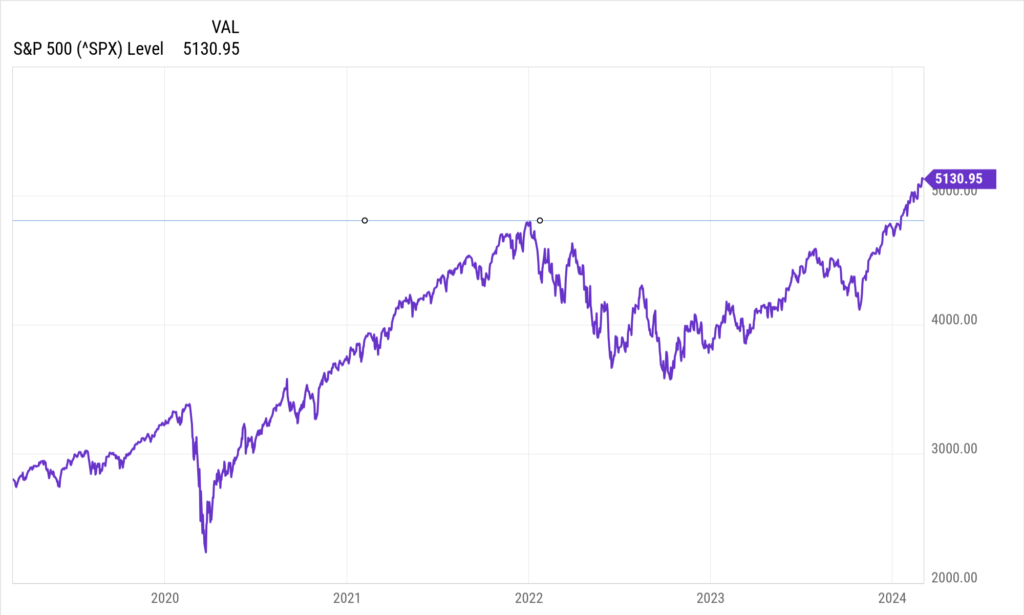The S&P 500’s impressive run since October 2023, with a 20% surge as of February 27, 2024, has left investors wondering if the market is reaching a peak or poised for further expansion. While the headline index boasts impressive gains, underlying data reveals mixed signals, prompting questions about whether this is a temporary top or a sign of a broader market participation.
Evidence for a Potential Top:
- 18-month Price Channel: The S&P 500 is currently hovering near the upper bound of an established 18-month price channel. As seen in [Figure 1], this channel has historically acted as a resistance zone, with the index experiencing periods of consolidation or correction upon reaching this point.

[Figure 1: 18-Month Price Channel for the S&P 500 (Source: YCharts)]
- Limited Sector Participation: Despite the S&P 500’s strong performance, the rally has not been universally shared. Sectors traditionally considered defensive, such as financials and healthcare, have significantly underperformed the broader market. As of February 24, 2024, the Financials Select Sector SPDR Fund (XLF) is down 3.4% year-to-date, while the Health Care Select Sector SPDR Fund (XLV) is up only 6.5%, compared to the S&P 500’s 20% gain. This lack of participation from these sectors raises concerns about the market’s overall breadth and sustainability.
Arguments for Broader Market Participation:
- Recent Sector Rotation: While lagging initially, there are signs of broader market participation emerging. Sectors like energy (XLE), communication services (XLC), and consumer discretionary (XLY) have recently outperformed the market, suggesting a potential shift away from technology leadership. As seen in [Figure 2], these sectors have seen significant gains in the past month, compared to the previous six months.

[Figure 2: Sector Performance Comparison – Past Month vs. Past 6 Months (Source:YCharts)]
- Healthy Economic Fundamentals: Despite recent market volatility, underlying economic fundamentals remain relatively strong. The unemployment rate currently sits at 3.8%, and inflation has moderated to 4.5%, as reported by the Bureau of Labor Statistics. This economic stability could provide support for continued market expansion, even if the pace slows down.
HLTR (Horizontal Line Through Resistance) in Focus:
The S&P 500 is also approaching its HLTR (Horizontal Line Through Resistance), a significant technical level formed by connecting previous highs. As seen in [Figure 3], a decisive break above this level, currently around 4,800, could signal a continuation of the uptrend. However, a rejection at this point could indicate a potential pullback.

[Figure 3: S&P 500 with HLTR (Source: YCharts)]
Additional Considerations:
- Geopolitical tensions: Ongoing geopolitical uncertainties, such as the ongoing war in Ukraine and rising tensions between the US and China, could act as headwinds for the market, potentially impacting investor sentiment and leading to increased volatility.
- Federal Reserve policy: The Federal Reserve’s monetary policy decisions, particularly regarding interest rate hikes and quantitative tightening, will significantly impact the market environment. Continued rate hikes could lead to higher borrowing costs and potentially dampen market enthusiasm.
Conclusion:
The current market presents a complex picture. While technical indicators and lagging sectors suggest a potential top, recent sector rotation, healthy economic fundamentals, and the approaching HLTR paint a more nuanced picture. Investors should closely monitor price action, economic data releases, and geopolitical developments to navigate this evolving market landscape.
Disclaimer: All performance referenced is historical and is no guarantee of future results. All indices are unmanaged and may not be invested into directly. This is a hypothetical scenario for educational purposes only and should not be considered financial advice. Please consult a qualified financial advisor before making any investment decisions. This blog post is for informational purposes only and should not be construed as financial advice. Please consult with a qualified financial advisor before making any investment decisions.

